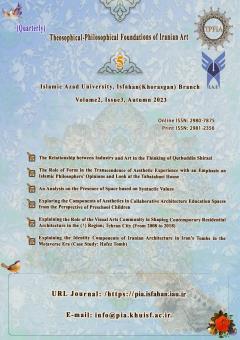The Role of Form in the Transcendence of Aesthetic Experience with an Emphasis on Islamic Philosophers’ Opinions and Look at the Tabatabaei House
Subject Areas : Art
Maryam Bakhtiarian
1
![]() ,
Firoozeh Sheibani Rezvani
2
,
Firoozeh Sheibani Rezvani
2
![]()
1 - Assistant Professor, Department of Philosophy, Science and Research Branch, Islamic Azad University, Tehran, Iran (Corresponding author)
2 - Assistant Professor of Art Department, Islamshahr Branch, Islamic Azad University, Islamshahr, Iran.
Keywords: Aesthetic Experience, Form, Islamic Art, Tabatabaei House, Transcendence.,
Abstract :
The purpose of this research is to explain the role of the Islamic form and its relationship with meaning in Islamic art, from the perspective of thinkers in this field by citing examples of architecture in the Islamic era. In this qualitative research, the possibilities of form in the excellence of Islamic art, beauty criteria from the perspective of Islamic sages, and considering the formal elements in the architecture of the Tabatabaei family's house were described and analyzed. The results of this research can be summarized as follows; from the point of view of known Islamic philosophers, the importance of the form in the excellence of Islamic art is that the audience approaches the spiritual experience through this art. In comparing the position of the form in Islamic aesthetics with the concept of form in Western aesthetic thinking, it is evident that the role of the Islamic form is in discovering and recognizing mysteries in the phenomena, and the importance of this role can only be identified in the connection between the form and its meaning. Islamic formal elements such as centrism and geometry, symbol and code, light and color, and abstraction have clear evidence in artistic works such as carpet art, painting, calligraphy, and architecture in the Islamic era. In a case study of the Tabatabaei house, elements such as center and geometry, code and symbol, color and light, and abstraction connect sublime concepts such as unity, goodness, perfection, and beauty.
آژند، یعقوب.(1384). سلطان محمد نقاش. تهران: فرهنگستان هنر.
ابن¬سینا، حسين¬بن¬عبداالله. (1376)، الالهيات من کتاب الشفاء، تحقيق حسن¬زاده آملي، قم: دفتر تبليغات اسلامي حوزۀ علميۀ قم.
ابن¬سینا، حسين¬بن¬عبداالله. (1383)، الاشارات و التنبيهات، ج2و3، شرح خواجه نصيرالدين طوسي، قم، نشر البلاغه.
ابونصر، محمد فارابی، (1379)، اندیشه¬های اهل مدینۀ فاضله، چاپ اول، ترجمۀ دکتر سید جعفر سجادی، تهران: سازمان چاپ و انتشارات.
امامی جمعه، مهدی، (1388)، فلسفۀ هنر در عشق¬شناسی ملاصدرا، تهران: فرهنگستان هنر.
ايمانوئل، کانت، (1383)، نقد قوۀ حکم، ترجمۀ عبدالکريم رشيديان، تهران: ني.
بورکهارت، تیتوس. (1381). هنر مقدس، اصول و روشها، ترجمه: جلال ستاری، تهران: صدا و سیمای جمهوری اسلامی ایران (سروش).
بورکهارت، تیتوس. (1386). مبانی هنر اسلامی. ترجمه و تدوین امیر نصری، تهران: حقیقت.
دینانی، غلامحسین ابراهیمی. (1384). درخشش ابن رشد در حکمت مشاء. تهران: طرح نو.
سهروردی، شهاب¬الدین. (1355). حکمه الاشراق، در مجموعه مصنفات شیخ اشراق، به تحقیق هانری کربن، تهران: انتشارات انجمن حکمت و فلسفه، چاپ اول.
سهروردی، شهاب¬الدین یحیی. (1377). قصه¬های شیخ اشراق، ویرایش متن: جعفر مدرس صادقی، تهران، نشر مرکز، چاپ دوم.
شبستری، شیخ محمود. (1382). گلشن راز، به اهتمام کاظم دزفولیان، تهران : انتشارات طلایه.
شبانی داریانی، زهره.(1401). درآمدی برزیباشناسی ابن هیثم در کتاب المناظر، تهران: دانشگاه هنر.
شوان، فريتهوف. (1383). حقايق و خطاهايي دربارۀ زيبايي، (مجموعه مقالات هنر و معنويت)، ترجمۀ: انشاءالله رحمتي، تهران: فرهنگستان هنر.
صدرالمتألهين (ملاصدرا). محمد بن ابراهيمي شيرازي. (1363ش). مفاتح¬الغيب، تصحيح محمد خواجوي، تهران: مؤسسه مطالعات و تحقيقت فرهنگي.
صدرالمتألهين (ملاصدرا). (ق1340). رسالۀ سه اصل، به تصحيح و اهتمام حسين نصر، تهران دانشگاه تهران، دانشکدۀ علوم معقول و منقول.
صباغپورآراني، طیبه(1393). خانه ايراني : نقشمايههاي سنتي در خانهآرايي، تهران: پژوهشگاه فرهنگ ، هنر و ارتباطات.
طوسی، نصرالدین. (1367). اساس الاقتباس، تهران: انتشارات دانشگاه تهران، چاپ دوم.
عشایری، سواره امیر؛ بلیلان اصل، لیلا؛ ستارزاده، داریوش و حبیب، فرح (1401). "واکاوی نقش هندسه معقول و محسوس در معماری گند سلطانیه"، فصلنامه علمی مطالعات هنر اسلامی، دورۀ 19، شمارۀ 45، 49-27.
غزالی، احمد. (1388). سوانح. به اهتمام قاسم کشکولی. چ 1. تهران، ثالث.
فضائلي، حبيب الله. (۱۳۷0). تعليم خط، تهران: سروش.
ملازاده، ناهم و محمدي، مريم(1386). خانههاي تاريخي(از مجموع دايرهالمعارف بناهاي تاريخ)، انتشارات سوره مهر.
مقيم پور بيژنی، طاهره .(1387). "آیينه¬کاری در معماری دوره قاجار، نگاهی مختصر بر پيشينۀ آیينه و کاربرد آن در تاریخ هنر ایران"، کتاب ماه هنر، شمارۀ 113، 70-77.
ندیمی، ضحی؛ محمدی، علی و مندگاری کاظم. (1392). "بازخوانی مفهوم مرکز: تبیین مفهوم مرکز از دیدگاه سه اندیشمند حوزۀ هنر و معماری"، مجله صفه فصلنامه هنر و معماری ، شمارۀ 63، 34-21.
یونگ، کارل گوستاو. (1377). انسان و سمبول¬هایش، ترجمه: محمود سلطانیه، تهران: چاپخانه دیبا.
Arnheim, Rudolf. (1988). THE Power of the Center, A study of composition in the visual arts, London, England, University of California press.
Farouqi, Lois. (1977), “The Aesthetics of Islamic Art”, the Journal of Aesthetics and Art Criticism, Vol. 35, No.3, PP. 353-355. Https://doi.org/10.2307/430294.
Lyotard Jean-Francios. (1991). Lessons on the Analytic of the Sublime, Trans. Elizabeth Rottenberg, Stanford University Press.
Stern-Gillet, Suzanne. (2002). A Companion to Art Theory, Neoplatonic Aesthetics, Edited by Pual Smith, Carolyn Wilde, Blackwell.
Tatarkiewicz, Wladyslaw. (1980), A History of Six Ideas: an Essay in Aesthetics, Melborn International Philosophy Series, Vol.5.


